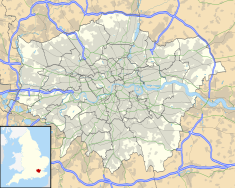| Inverforth House | |
|---|---|
 | |
| Location | North End Way, Hampstead, London, NW3 |
| Coordinates | 51°33′53.4″N 0°10′51.44″W / 51.564833°N 0.1809556°W |
| Built | 1895 |
| Architect | Grayson and Ould |
| Architectural style(s) | British Queen Anne Revival style |
| Governing body | Privately owned |
Listed Building – Grade II | |
| Official name | Inverforth House |
| Designated | 7 September 1988[1] |
| Reference no. | 1113185 |
Inverforth House (formally known as The Hill) is a large detached house on North End Way at North End on the outskirts of Hampstead in the London Borough of Camden, NW3.[2][3] Owned by William Lever, 1st Viscount Leverhulme from 1904 to 1925, The Hill was bought by Andrew Weir, 1st Baron Inverforth after Leverhulme's death in 1925, and following was given to Manor House Hospital after Inverforth's death in 1956.[1]
It became the women's section of Manor House Hospital, with about 100 beds and a Nurses' Home for 60-70 staff. Never part of the NHS, the Hospital was funded by the Industrial Orthopaedic Society, a trade union.[4][5]
According to the developer, mistakenly, Inverforth House was home to the Orthopaedic Society Hospital from the 1950s to the 1980s, and was converted into two houses and seven apartments in the late 1990s.[6]
Rebuilt in the British Queen Anne Revival style in 1895 by the architectural firm Grayson and Ould, it is a Grade II listed building.[1] Built from red brick, Inverforth House has a steeply pitched roof. The architectural style of Inverforth House has been described as "Neo-Georgian" with "Queen Anne style wings".[1]
In 2002 English Heritage commemorated Viscount Leverhulme and geneticist and statistician Ronald Fisher, who lived there as a child from 1896 to 1904, with blue plaques.[7][8]
- ^ a b c d Historic England. "Inverforth House (1113185)". National Heritage List for England. Retrieved 29 January 2013.
- ^ Cherry and Pevsner 1999, p. 217.
- ^ Cherry and Pevsner 1999, p. 218.
- ^ https://www.ezitis.myzen.co.uk/inverforth.html
- ^ https://wellcomecollection.org/works/nxqt58s5
- ^ "I'm sorry, I'll build that again..." The Daily Telegraph. Archived from the original on 26 February 2011. Retrieved 9 December 2013.
- ^ "Fisher, Sir Ronald Aylmer (1890–1962)". English Heritage. Archived from the original on 16 December 2013. Retrieved 30 January 2012.
- ^ "Lever, William Hesketh, 1st Viscount Leverhulme (1851–1925)". English Heritage. Retrieved 30 January 2012.
